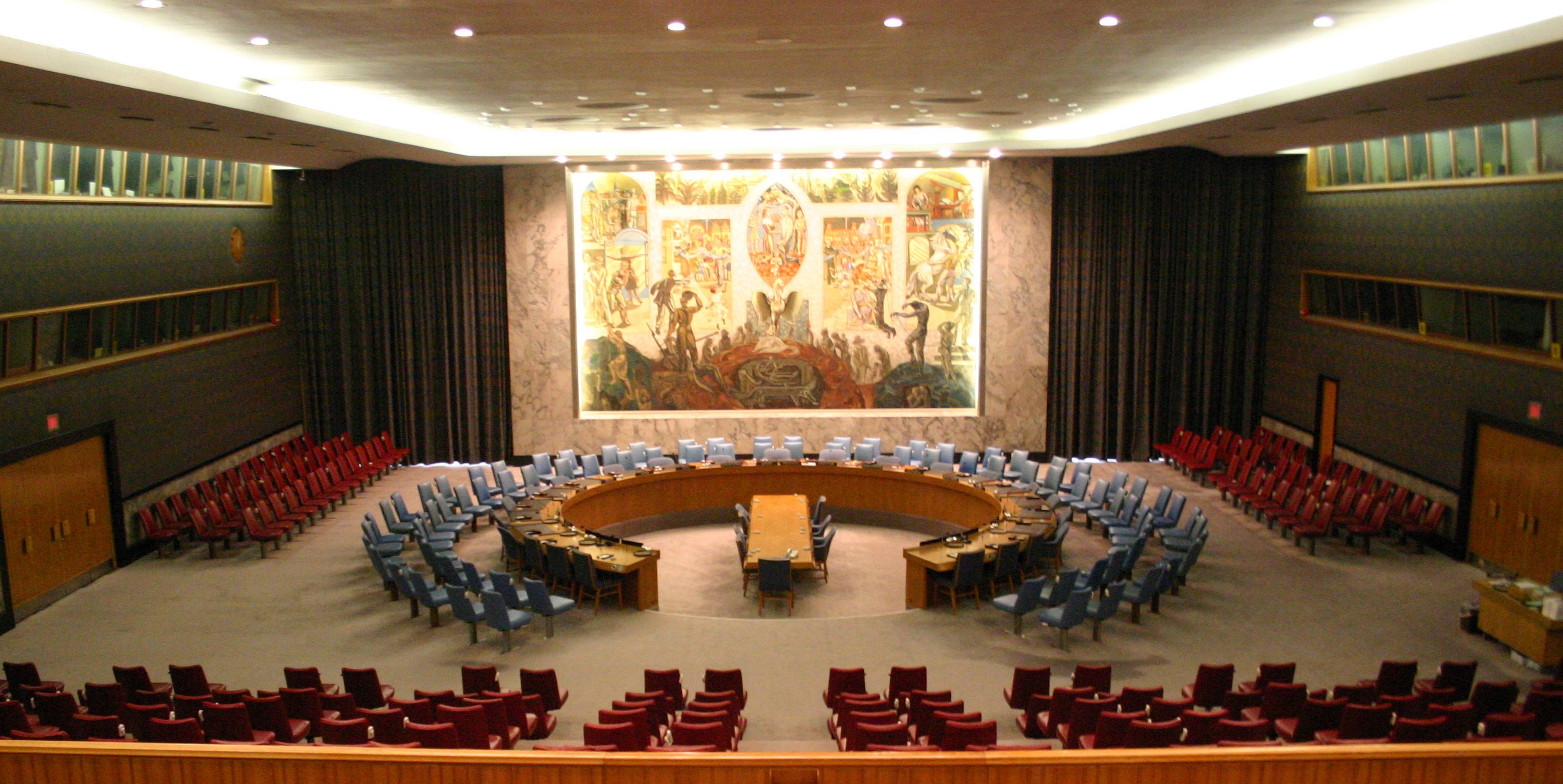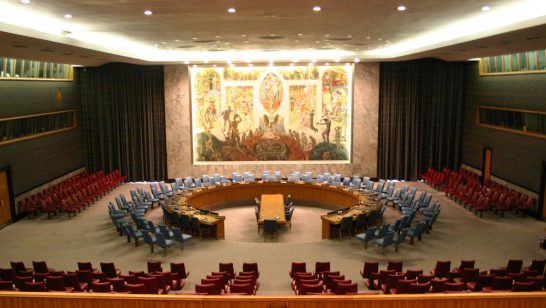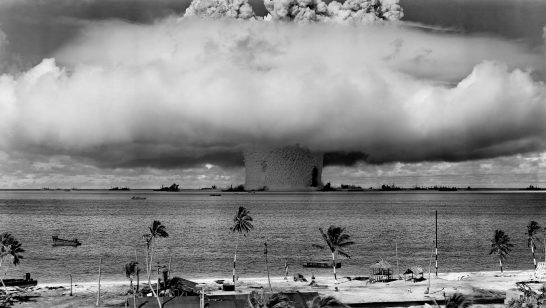
2020 marks 75 years since nuclear weapons were used on the cities of Hiroshima and Nagasaki. It will also be 50 years since the Treaty on the Non-Proliferation of Nuclear Weapons (NPT) entered into force and 25 years after the landmark conference that extended the Treaty indefinitely. Making the NPT permanent was part of interlinked decisions in 1995 on reviewing and implementing its nuclear disarmament and non-proliferation obligations, together with a resolution on establishing a zone free of weapons of mass destruction (WMD) in the Middle East.
The third preparatory committee meeting (PrepCom) for the 2020 Review Conference (RevCon) finished earlier this month in New York, attended by over 150 of the 191 states parties. In diplomatic terms, the 2019 PrepCom was better than feared. Ably chaired by Malaysia’s Ambassador Syed Md Hasrin Syed Hussin, the meeting adopted necessary procedural requirements, including the nomination of Argentina’s Ambassador Rafael Grossi as president of next year’s RevCon. However, despite the Chair’s valiant efforts, the PrepCom could not agree on substantive recommendations on the major issues it had been discussing for two weeks.
This surprised no one. Getting consensus among NPT states is always difficult. In 1995, 2000 and 2010 RevCon agreements were only forged in the final couple of days, so aiming to arrive at consensus recommendations a year in advance was always unrealistic. That said, deep and substantive disagreements regarding heightened nuclear risks, proliferation, and actions by nuclear armed states that violate the NPT obligations indicate that constructive agreements in 2020 will be very difficult to achieve. At stake are not just diplomatic outcomes but global security.
Though much discussed, US President Donald Trump’s posturing is not the only problem. Tackling the non-proliferation regime’s weaknesses will take responsible leadership, and that does not look likely to come from any of the nuclear-armed states any time soon. By contrast, the major development since the 2015 RevCon is the 2017 Treaty on the Prohibition of Nuclear Weapons (TPNW), which was led by over 130 non-nuclear NPT parties and negotiated under UN General Assembly auspices, where it was adopted by 122 votes to 1 (Netherlands, with Singapore abstaining). Appearing somewhat sidelined in 2018, the TPNW was in the mainstream of 2019 PrepCom discussions and documents, with opposition expressed by just a handful of states that continue to endorse the use and possession of nuclear weapons.
P5 rivalries undermine the NPT
This year, as predicted, there was no joint statement from the five nuclear-armed states on the UN Security Council. In 2019, the “P5 process” that Gordon Brown initiated in 2009 was chaired by China, which reported that there had been a “frank and in-depth exchange of views” at its meeting in Beijing in January. Referring to on-going work on a “glossary of key nuclear terms”, the Chinese delegation said that the P5 “reaffirmed their commitments to jointly fulfilling the responsibility of maintaining international peace and security, safeguarding the NPT regime, and enhancing coordination and dialogue among themselves”. The words might appear encouraging, but the facts on the ground are not. A glossary may be useful but it will not halt a resurgent nuclear arms race or fulfil NPT obligations to eliminate nuclear arsenals. The UK, which succeeds China as P5 coordinator in 2020, will have to navigate an obstacle-strewn path if it is to have any chance of persuading the P5 to create the conditions for a successful RevCon next year.
Far from fulfilling their responsibilities, P5 policies and rivalries are major problems for the NPT, as well as international peace and security. The record since the 2015 RevCon is abysmal, notably:
- Washington’s unilateral withdrawal from the 2015 Joint Comprehensive Programme of Action (JCPOA) that was plurilaterally negotiated with Iran and unanimously adopted through UN Security Council resolution 2231;
- US-Russian actions to undermine and pull out of the 1987 Intermediate-Range Nuclear Forces (INF) Treaty;
- the North Korean nuclear stalemate despite last year’s high profile summits; and
- failure to get started on the 1995 commitments to negotiate a zone free of WMD in the Middle East, despite these commitments being made central to agreements adopted by the 2010 RevCon.
US withdrawal from the JCPOA was castigated from many sides, but that didn’t prevent the American delegation criticizing Iran at every opportunity. As Trump turned the screw with sanctions and threats, his National Security Advisor John Bolton announced during the PrepCom that a carrier strike fleet and bombers would be deployed to the Persian Gulf. Though concerns about military action have grown, and many have warned that the Trump administration’s behaviour is cornering Iran into violating the JCPOA and may even cause it to withdraw from the NPT , little has been done by the other signatories to challenge the Trump-Bolton narrative. US withdrawal from the JCPOA has put President Hassan Rouhani’s policy of restraint under tremendous pressure from Iranian hardliners. He has repeatedly sought assurances from the other signatories, promising to adhere to the JCPOA if the other signatories would continue to implement their commitments in accordance with UN Security Council resolution 2231. Instead, they are crumbling under Trump’s economic and political threats, making Iran more vulnerable and isolated than ever, with potentially disastrous consequences for non-proliferation and security.
The fate of the INF Treaty demonstrates further failures among NPT states to address real world proliferation threats. This bilateral, regionally-important disarmament Treaty broke new ground in 1987 and heralded deep cuts as the Cold War ended. Thirty years later, Trump and Russian President Vladimir Putin have brought it down with their arms racing and missile modernization projects. Even as Europeans lament that Trump’s flag-waving for American exceptionalism is feeding Putin’s efforts to destabilize Western cohesion and security, the demise of the INF Treaty appears to be a done deal. NATO governments and NGOs are now casting around for ways to “save” and extend New START, which they fear will be the next Bolton-Trump victim. Some argue for extending the INF prohibitions to China and others with medium range missile programmes, but China isn’t going to go along with that, even if India and Pakistan would agree (which is unlikely). There are growing calls for NATO states to reduce the risks of nuclear war by declaring their refusal to allow medium-range nuclear weapons to be redeployed in Europe. While some are reviving fifty-year-old calls for security assurances from the P5 (ignoring the fact of there now being nine nuclear arsenals to worry about), there are growing discussions of how the TPNW can bridge the legal, normative and verification gaps, as it evolves its institutional and technical capabilities to enforce its unequivocal prohibitions on the use of nuclear weapons and various production, testing and deployment activities that make the possession and use of nuclear weapons possible.
Risks and Bridge Building
The 2019 PrepCom also illustrated forward movement in its discussions on nuclear risks, de-alerting, and the gendered underpinnings of nuclear weapons policies and practices. These have become connected with the “bridge-building” discourses that cut across geopolitical groupings. They go beyond recognition of the historical and humanitarian facts to considering how to build agreements to reduce nuclear risks and increase diversity and effective engagement at all levels of disarmament and security work. The mainstreaming of these issues, along with acknowledgment of rights and assistance for “victims” of military policies, is due in large part to nuclear ban campaigners, who updated studies on nuclear impacts, risks, gender and disarmament while raising awareness of the humanitarian consequences of nuclear weapons.
While positive references to the TPNW abounded, its most vociferous opponent at the PrepCom was France. This may have been tactical, but it appeared that the other nuclear armed states and NATO members were, if anything, embarrassed by the French delegation’s strident denunciations. In any case, as discussions over the two drafts of the Chair’s working papers illustrated, there is now widespread acceptance of the reality of this new legal instrument, even by governments that worry about its impact on public opinion, nuclear policies and defence arrangements.
Presenting British nuclear weapons as a “minimum, credible”, form of deterrence and “a political, not a warfighting, tool”, the UK’s statements, national report and side events emphasised ongoing programmes relating to nuclear security, diplomacy, verification and safeguards. Calling on others to increase transparency and confidence-building measures, the UK summarised its “operational policy”, current stockpile and work on verification, and pledged “to host the next P5 Conference in London before the 2020 NPT Review Conference”. By comparison with 2018, British positions were more open and constructive, probably influenced by the report from the House of Lords International Relations Committee on “Rising nuclear risk, disarmament and the NPT“. In formal sessions, however, Britain still steered close to the US positions, while privately expressing reservations. As tens of billions of pounds continue to be sunk into building Dreadnought submarines for a new generation of Trident nuclear weapons, the UK had nothing to offer on disarmament, and instead focussed on its activities to promote “peaceful uses of nuclear energy”.
Like Britain and China, France was enthusiastic about promoting nuclear power, making this rather than nuclear disarmament the measure of its support for the NPT. These were not the only states to boost their NPT credentials by evoking their Article 4 actions rather than tackling the spread of nuclear weapons. Years of statements from Non-Aligned Movement (NAM) states evoke the “three pillars” metaphor like a mantra, unwittingly playing into the nuclear-armed states’ strategy of claiming nuclear energy assistance as if it were an NPT obligation as vital as preventing proliferation and eliminating the arsenals. In fact, the “three pillars” idea was invented in the 1980s to solve an administrative problem. It is at such times that the institutional memories and insights of scholars and diplomats are important to help distinguish treaty facts and obligations from more ephemeral developments, and avoid non-proliferation, disarmament and diplomacy becoming trapped by the administrative choices and incentive structures of the past.
Even for states that advocate action to prevent further climate destruction, nuclear power technologies have ceased to be environmentally and economically attractive, as illustrated in a side event by the Princeton-based International Panel on Fissile Materials (IPFM) on 7 May. Article 4, which (notwithstanding the official statements) is mainly useful for meeting medical and agricultural development needs, was inserted as an incentive for non-nuclear states to join the NPT. Only the governments that want to keep their nuclear options open regard it as sacrosanct. Along with Article 5 (which expresses a right to conduct “peaceful” nuclear explosions), this so-called “inalienable right” is being overtaken by reality and the unsolved problems of nuclear production, waste and proliferation.
Since nuclear power is no longer the attractive incentive it was intended to be in 1968, the NPT must stand or fall by how well it meets the security imperative at its heart.
The US initiative entitled “creating the environment for nuclear disarmament”(CEND) gets this at some level, but turns it inside out. In his opening statement, US Assistant Secretary for International Security and Nonproliferation Christopher Ford cited the necessity to ensure North Korea’s “fully-verified denuclearization”, “block Iran’s pathways to nuclear weaponry”, “hold Syria accountable for its NPT and IAEA safeguards violations”, and “strengthen existing safeguards”. These objectives are shared by many. Few, however, share Ford’s analysis and enthusiasm for convening a “Creating the Environment Working Group” (CEWG), though they would find it difficult to refuse if Washington invites them to join. CEND is viewed with much cynicism, as a way to avoid taking responsibility for adhering to nuclear treaties and getting rid of nuclear weapons. Instead of the concrete measures in the “Thirteen Steps” adopted by the 2000 RevCon, which the US now repudiates, Ford “imagines” CEND steps to “change the security environment in order to reduce incentives for states to retain, acquire, or increase their holdings of nuclear weapons”, “bolster nonproliferation efforts and build confidence in nuclear disarmament”, and “reduce the likelihood of nuclear war among weapons possessors during the period of time that remains before such weapons are eliminated”.
The problem, as critics have pointed out, is not what Ford would like to imagine, but the present security reality, in which the deep contradictions between US rhetoric and actions are a negative factor. However dressed up, CEND muddles causes and effects and attempts to reverse the security-nuclear-insecurity connections while assiduously avoiding any acknowledgment of NPT-undermining roles played by military-industrial-bureaucratic-academic (MIBA) establishments in the United States and other nuclear armed states.
Divisions over substantive recommendations
Treaties have to be more than their processes. They need to connect with geostrategic politics and interests in the world as it is, and not as it was 50 or 25 years ago. Even a year can transform how people see the world when international security is threatened by nuclear weapons and the drumbeats of war.
When Ambassador Hussin presented the first draft “Recommendations to the 2020 Review Conference”, he steered close to the joint working paper from the Dutch and Polish Chairs of the 2017 and 2018 PrepComs. Following two days of intense discussion among the delegates, he issued a second draft that took into account all the views, proposals and responses that were raised in that debate. In the ensuing debate the majority of delegations commended the Chair and his team for listening so well and taking on board most if not all their responses to the first draft, thereby making the second draft more balanced and representative than before.
The loudest critics were the United States and France. US Ambassador Robert Wood criticized the second draft as “dramatically worse”, and recommended that the Chair should “go back to your first draft”. Soon after, the French ambassador expressed his “incredible disappointment”, and complained that the second draft contained “harmful elements” that “threaten the NPT and its norms”. Russia and China appeared more willing to accept this draft as a “basis for further consultations”, but the UK backed US demands to go back to the first draft, complaining that “what we supported has disappeared and what we opposed is still there or even strengthened”. US allies Germany, Japan, Norway and Canada (among others) thanked the Chair for incorporating their particular proposals into his second draft and then, rather sheepishly, called on him to revert to the first draft.
Among many who congratulated the Chair, Brazilian Ambassador Guilherme de Aguiar Patriota captured the essence of this final debate when he called the second draft a more accurate reflection of the discussions in 2019 than the summaries from the two previous Chairs. Underlining that the NPT represents over 190 nations, Patriota expressed the support of the New Agenda Coalition and characterised the second draft as “closer to the middle ground… closer to the spirit of the NPT and what it actually establishes”. South Africa’s ambassador reminded naysayers that “We can’t expect to be satisfied with everything unless we are only negotiating with ourselves. The NPT belongs to all of us, and not just a small cartel that abrogates to itself what is acceptable.”
Recognizing the impossibility of reaching consensus on the final day, Hussin promised to issue the second draft as a working paper under his own responsibility, as all third PrepCom Chairs have done since 1999. He also issued a short “Reflections” paper from his position as Chair of the 2019 PrepCom.
Towards 2020: the need for common understandings
Having received the PrepCom’s endorsement as president designate (with finalization expected by the end of the year) Ambassador Rafael Grossi had the last word. Promising to start immediately, work hard and consult widely, Grossi spoke of “looking at what unites us and what can be put to good use to strengthen the treaty”. For this to happen, he needs to address how nuclear technologies and weapons are perceived in today’s world, and the security imperatives that need to be addressed through the NPT, TPNW and other NPT-related agreements and agencies.
Despite deteriorating relations among nuclear-armed states, and the apparent willingness of certain leaders to undermine international legal agreements that their nations have previously undertaken in good faith, Grossi told the PrepCom that he took heart that “there is common understanding that failure next year is in no one’s interest”. Recalling similarities between now and 2005, when Bolton previously had a US president’s ear (George W. Bush), his outcomes were chaos in the Middle East and the worst RevCon failure in NPT history. We have to hope the war drums are quietened and that Grossi’s optimism going into 2020 is not betrayed by the machinations of Bolton or any of the nuclear-armed leaders.
The opinions articulated above also do not necessarily reflect the position of the European Leadership Network or any of its members. The ELN’s aim is to encourage debates that will help develop Europe’s capacity to address pressing foreign, defence, and security challenge.
The author is grateful to many diplomats and colleagues for sharing their thoughts on the PrepCom. Particular thanks go to Ray Acheson for her insightful analyses, and Allison Pytlak, Katrin Geyer and the whole Reaching Critical Will team for their helpful reporting in NPT News in Review, their detailed analysis of the differences between the first and second draft recommendations, and the invaluable service they provide in posting all available documents and statements on their website.





